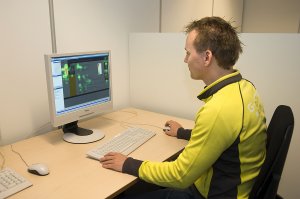Eye-tracker Labs
The human eye can distinguish the fine details that are needed for reading or face recognition only in the centre of fixation. Although we are not consciously aware of this, visual information in the periphery of the visual field is coarse. Therefore, the human eye constantly moves to fixate on the part of the environment that needs to be processed. These movements occur as sudden jumps (called saccades) from one location to another. By using a remote, digital eye-tracker, we can record saccades and fixations, the length of each fixation, the pupils’ diameter, and a lot of other useful data within an accuracy of half a degree. Thus, eye-tracking can, for example, tell us what a user is looking at and for how long.
In educational research, eye movement tracking provides a valuable input for studying learning processes. For example, if a researcher intends to study the effect of a certain instruction on learning from multimedia, the pattern of eye fixations informs him about the information the learner has focused on in the screen. When comparing these eye fixations to those of a group of learners who did not receive the instruction, the researcher can draw conclusions about how the instruction affected learning. On the other hand, in expertise research, eye movement data provide insight into the problem solving steps experts go through when tackling a complex task. Research in chess, for example, has shown that grandmasters tend to segment the chess board in clusters to minimize processing demands when playing chess, whereas inexperienced chess players view the chess board as a whole. Knowledge about how experts solve problems is valuable for improving the training and performance development of non-experts.
Likewise, researchers in Marketing are interested in eye-tracking data to study consumers' attention to advertising, commercials, packages, shelf layouts, and webpage design. In the past, eye-tracking equipment was not suitable for consumer research, since it was extremely time consuming to collect data from a relatively large sample of different consumers. However, recent technology, like the eye-trackers of Tobii, allows marketing researchers to collect data from a large sample of consumers. (Tobii has a sampling rate of 50Hz and an average gaze position error of 0.5° - 1°).
The EBL has two Tobii 2150 Eye Trackers in use.

The eye tracker records eye movements

Eye fixations are highlighted in the output


